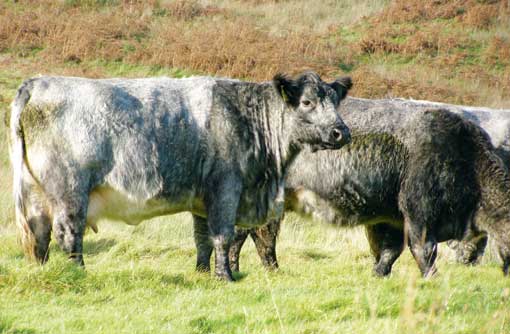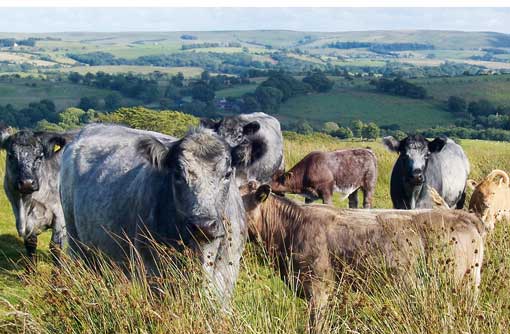Blue-Greys: the most profitable suckler cow around

In a time of increasing input costs and unpredictable weather, could the Blue-Grey suckler cow be the answer to rising unpredictabilities? Jeremy Hunt finds out
The Blue-Grey suckler cow may not be the breed of choice for many beef producers, but it could be the most profitable one.
Its characteristics of being hardy, easy calving, fertile with good maternal abilities make it one of the most profitable breeds, with results from a recent study supporting this.
Profitability
Scotland’s Rural College (SRUC) found the Blue-Grey suckler cow – produced by crossing a Whitebred Shorthorn bull with a Galloway cow – significantly out-performed other cross-bred sucklers achieving an £84 a head profit.
This compared with the QMS national hill suckler herd average which showed a £182 a head loss, while the QMS national upland suckler herd average showed a £112 a head loss.
And with their low cost, minimal management and high output, the Blue-Grey should be any hill farmer’s dream, says Karen Telford, secretary of the Blue-Grey Cattle Group.
“The Blue-Grey has abundant milk to feed the quickly growing continental-sired calf and an ability to keep and maintain flesh even in the roughest out-wintering conditions. Longevity, good health, easy care and established conservation grazing credentials add to the breed’s appeal,” she says.
The SRUC report showed vet and medical costs of the herds involved in the study averaged £12.59 a head compared with the QMS national hill cow average of £49. And the average age of a Blue-Grey cow at culling was 13 years compared with the QMS average of seven years.
“Most impressive were calving percentages which averaged 92% compared with the QMS national average of 84%,” says Ms Telford.

And one farmer who knows just how good the attributes of the Blue-Grey are is William MacTier, a partner in the family farming business that runs about 120 Blue-Grey sucklers put to the Simmental.
“No other suckler cow has the hardiness, longevity and fertility of the Blue-Grey, says Mr MacTier. “This is a cow that looks after itself. Our cows remain outside all year round; their health and vigour is remarkable and feed costs are minimal,” he adds.
The herd is owned by William, his brother Robert and sister Ann and is run on two farms alongside Cheviot ewes on 375ha. Two-thirds of the herd calves in autumn – including all first-calf heifers – with the rest in spring. All calves are sold at the Newton Stewart store calf sale in October with most going to the same buyers every year.
The herd’s policy is to buy-in yearling Blue-Grey heifers from the annual sale at Newcastleton and to calve them at three years old to the Welsh Black bull, after which all subsequent calvings are to the Simmental.
Health
“The fertility of the Blue-Grey is excellent – they never miss having a calf. And as a vet I know they are extremely healthy; we never touch any feet, never have any lameness, mastitis isn’t an issue and calves don’t suffer from scours,” says Mr MacTier.
“We only make 40 acres of silage in total. This year we started to feed it to the autumn calvers on 7 January and we’ll probably have stopped by early April. The spring calvers get nothing at all until mid-March when we feed them a little up to calving in April. It’s a truly easy-care system with cows out on the hill all year round. If the weather gets bad they don’t lose any flesh – they just grow a bit more hair.”
Even in the hardest weather out on the hill, Blue-Grey cows are renowned for holding their body condition: “If you get your hands on the spring calvers – who get nothing at all during the winter – you’ll find they have a condition score of about 3.5. It’s a lot to do with the hybrid vigour and the hardiness of the two component breeds – the Galloway and the Whitebred Shorthorn.
“We had the Farm Assurance visit in mid-February and the chap commented on how well they looked even at that stage of the winter. I don’t believe there is any other breed that can cope as well as they do.”
Newly bought replacement heifers are turned out as soon as they arrive on the farm and fed about 1kg a head of calf mixture which is continued throughout the winter and usually increased to about 2kg along with some hay into mid-February – depending on the grass – to maintain growth. The bull is turned out with the maiden heifers on New Year’s Day for calving the following October.
“I’m not pre-occupied with size in these yearling heifers when I buy them. I want good type, strength and vigour,” says Mr MacTier.
Longevity
Like all those who have remained loyal to the Blue-Grey he agrees “these cows never die”. “The only way to stop them breeding when they get too old is to keep the bull off them. The oldest cow in the herd is 15 years old and she’s calved every year. Most cows don’t go off the farm until they are well into their teens,” he says.
“The usual problems that mean a suckler cow has to be culled aren’t an issue with the Blue-Grey. They have excellent feet, always have good udders and are very fertile. It’s purely the fashion to keep continental cross cows that has caused the fall in popularity of the Blue-Grey, but the report published last year has proved just how profitable they can be.
“And we certainly saw more new faces around the ringside at Newcastleton last October so people are beginning to take notice again.”
All calves produced on the farm are sold as store cattle in October. While Mr MacTier says he knows his calves will never be among the highest prices on the day, it’s what those calves cost to produce that makes the Blue-Grey profitable.
“I have regular buyers for the Simmental-sired calves out of the Blue-Grey. The best bullocks are bought by the same man every year. He takes them home, outwinters them on silage and finishes them off the grass in summer with no extra feeding at all. That’s why he keeps coming back for them.” Last year’s store calves produced by the MacTier partnership were achieving up to £700 a head for the best bullocks.
Keep up to date with all the latest livestock sale and show news
